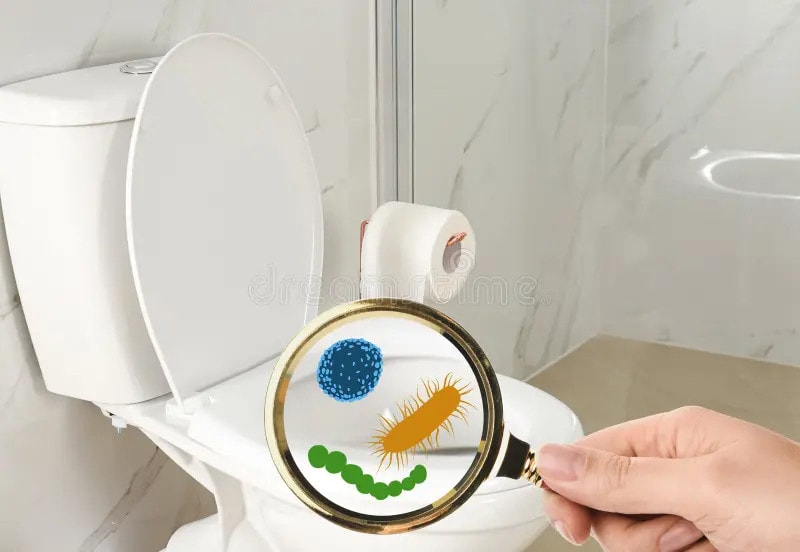Are you worried about catching an STD from toilet water in public restrooms?
Let’s address this common concern and put your mind at ease.
It’s time to separate fact from fiction and uncover the truth about the transmission of sexually transmitted diseases.
We understand your concerns and want to provide you with accurate information.
So, let’s dive into the topic and debunk the myth surrounding STDs and toilet wat
Table of Contents
The Myth and Reality
There are several misconceptions surrounding the transmission of sexually transmitted diseases (STDs) from toilet water.
In this section, we will address these myths and provide accurate information to debunk them.
- Common misconceptions about toilets and STDs: Many people believe that they can contract an STD from toilet water or toilet seats in public restrooms. This fear often stems from the idea that pathogens can survive on surfaces and infect individuals who come into contact with them. However, the risk of contracting an STD from toilet water is extremely low, as most STDs are transmitted through sexual contact, blood-to-blood contact, or skin-to-skin contact[1].
- The origin of the myth: The myth that STDs can be contracted from toilet water likely originated from a lack of understanding about how these diseases are transmitted. In the past, people may have attributed unexplained infections to contact with contaminated surfaces, such as toilet seats or toilet water. However, modern research has shown that the transmission of STDs requires specific conditions that are not typically found in public restrooms. To summarize, the myth that you can contract an STD from toilet water is not based on scientific evidence.
The risk of contracting an STD from toilet water is extremely low, as these diseases are primarily transmitted through sexual contact, blood-to-blood contact, or skin-to-skin contact.
It is essential to focus on accurate information and prevention methods to protect yourself from STDs.
Understanding STDs
Before we debunk the myth of contracting STDs from toilet water, it’s essential to understand what STDs are and how they are transmitted.
What are STDs?
Sexually transmitted diseases (STDs) are infections that are spread through sexual contact.
They can be caused by bacteria, viruses, or parasites and can affect both men and women.
Some common STDs include:
- Chlamydia
- Gonorrhea
- Human papillomavirus (HPV)
- Herpes simplex virus (HSV)
- Syphilis
- Human immunodeficiency virus (HIV)
How are STDs transmitted?
STDs are primarily transmitted through sexual contact, including vaginal, anal, and oral sex.
Some STDs, like HIV and hepatitis B, can also be transmitted through blood-to-blood contact, such as sharing needles or during childbirth.
Skin-to-skin contact can transmit certain STDs, like HPV and herpes, even without sexual intercourse.
It’s important to note that the transmission of STDs requires specific conditions that are not typically found in public restrooms[1].
Now that we have a better understanding of STDs and their transmission methods, we can confidently address the myth of contracting STDs from toilet water in the next section, “”Toilet Seats: The Truth.””
Toilet Seats: The Truth
Why are toilet seats considered gross?
Toilet seats are often perceived as gross due to their association with public restrooms and the potential presence of germs.
This perception is further fueled by the fear of contracting diseases from toilet seats, especially in public restrooms where multiple people use the same facilities.
However, it’s essential to understand the actual risks associated with toilet seats and the likelihood of contracting diseases from them.
Known diseases on a toilet seat
While it’s true that toilet seats can harbor bacteria and viruses, the risk of contracting an STD from a toilet seat is extremely low.
Most STDs, such as HIV, HPV, and herpes, require specific conditions for transmission, which are not typically found on toilet seats.
These conditions include sexual contact, blood-to-blood contact, or skin-to-skin contact.
Some common bacteria found on toilet seats include E. coli and Staphylococcus, which can cause minor infections if they come into contact with broken skin or mucous membranes.
However, these infections are not sexually transmitted and can be easily prevented by practicing good hygiene, such as washing your hands after using the restroom.
In the upcoming section, “The Science Behind It,” we will delve deeper into the survival of pathogens on surfaces and the environment required for STDs to thrive.
This will help further clarify the risks associated with toilet seats and debunk the myth of contracting STDs from them.
The Science Behind It
The risk of contracting an STD from toilet water is extremely low due to the specific conditions required for the transmission of STDs.
Most STDs are transmitted through sexual contact, blood-to-blood contact, or skin-to-skin contact[1].
Survival of Pathogens on Surfaces
Pathogens, including those responsible for STDs, have varying survival rates on surfaces.
In general, most pathogens responsible for STDs do not survive long outside the human body.
For instance, HIV, the virus responsible for AIDS, can only survive for a few minutes to a few hours outside the body, depending on factors such as temperature and humidity[1].
The Environment Required for STDs to Thrive
STDs require specific conditions to thrive and be transmitted.
These conditions are typically not found in public restrooms or on toilet seats.
For example, the herpes simplex virus (HSV) and human papillomavirus (HPV) require skin-to-skin contact for transmission, while HIV and hepatitis B can be transmitted through blood-to-blood contact[1].
In summary, the likelihood of contracting an STD from toilet water is extremely low due to the specific conditions required for the transmission of these diseases.
The survival of pathogens on surfaces and the environment required for STDs to thrive are not typically found in public restrooms.
It is essential to focus on accurate information and prevention methods to protect yourself from STDs.
Toilet Water and Diseases
In this section, we will discuss the composition of toilet water and the implications of splashback, which are essential factors to consider when debunking the myth of contracting STDs from toilet water.
Composition of Toilet Water
Toilet water is primarily composed of clean water from the plumbing system, which is used to flush away waste.
However, when the toilet is used, the water can become contaminated with fecal matter, urine, and other bodily fluids.
Despite this contamination, the risk of contracting an STD from toilet water remains extremely low, as the specific conditions required for the transmission of STDs are not typically found in toilet water[1].
Splashback and Its Implications
Splashback refers to the phenomenon of toilet water splashing onto the user’s body when the toilet is flushed.
While this may be an unpleasant experience, it is important to note that the risk of contracting an STD from toilet water splashback is minimal.
As mentioned earlier, most STDs require sexual contact, blood-to-blood contact, or skin-to-skin contact for transmission, and these conditions are not met through mere contact with toilet water[1].
In conclusion, the risk of contracting an STD from toilet water is extremely low due to the specific conditions required for the transmission of these diseases.
It is essential to focus on accurate information and prevention methods to protect yourself from STDs.
In the upcoming section, “Prevention and Safety,” we will discuss practical steps you can take to minimize the risk of infection in public restrooms, such as hand washing, using barriers on toilet seats, and avoiding contact with high bacteria areas.
Prevention and Safety
Now that we have debunked the myth of contracting STDs from toilet water, it’s essential to focus on practical prevention methods to ensure safety in public restrooms.
In this section, we will discuss some steps you can take to minimize the risk of infection and maintain good hygiene.
Hand Washing

One of the most effective ways to prevent the spread of germs and infections is by washing your hands thoroughly with soap and water.
Make sure to wash your hands after using the restroom, as well as before and after eating or touching your face.
Hand washing helps remove bacteria and viruses that may be present on your hands, reducing the risk of infection.
Using Barriers on Toilet Seats
To minimize contact with germs on toilet seats, consider using a barrier, such as a toilet seat cover or a layer of toilet paper.
This can help reduce the risk of coming into contact with bacteria and viruses that may be present on the seat.
However, remember that the risk of contracting an STD from a toilet seat is extremely low, so using a barrier is more about personal comfort and hygiene.
Avoiding Contact with High Bacteria Areas
In public restrooms, some areas may have higher concentrations of bacteria, such as door handles, faucet handles, and flush levers.
To minimize contact with these surfaces, use a paper towel or tissue to touch them, or consider using your elbow or foot to operate them when possible.
This can help reduce the risk of coming into contact with germs and bacteria.
In conclusion, while the risk of contracting an STD from toilet water is extremely low, it’s essential to practice good hygiene and take preventive measures to ensure safety in public restrooms.
By washing your hands, using barriers on toilet seats, and avoiding contact with high bacteria areas, you can minimize the risk of infection and maintain good health.
Final Say So!
Conclusion: In the grand scheme of restroom worries, contracting an STD from toilet water shouldn’t top your list!
While the world of myths and misinformation is vast, this particular tale is flushed with inaccuracy.
Remember, STDs primarily spread through intimate contacts, not from your brief encounter with a toilet seat.
So, the next time you hear this old wives’ tale, you can confidently declare it as ‘busted’ and focus on genuine prevention methods.
Stay informed and stay safe! 🚽🚫🦠
FAQs
Is it OK to sit on a public toilet?
Yes, it’s generally safe to sit on a public toilet. However, it’s always a good idea to wipe the seat with toilet paper or use a seat cover for extra hygiene.
How do you prevent infection in public toilets?
To prevent infection in public toilets, always wash your hands thoroughly with soap and water after using the facility. Additionally, avoid touching surfaces with bare hands and consider using a tissue or paper towel to touch handles and faucets. Using a seat cover or wiping the seat with toilet paper can also help.


